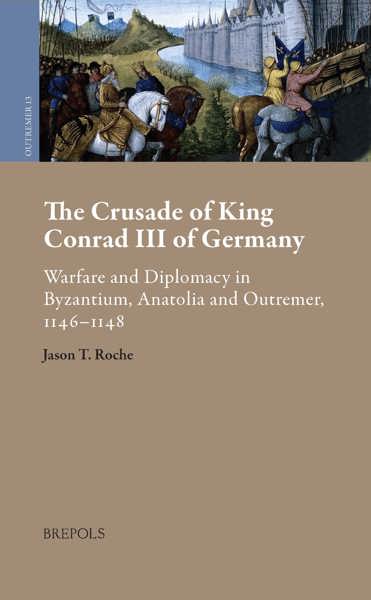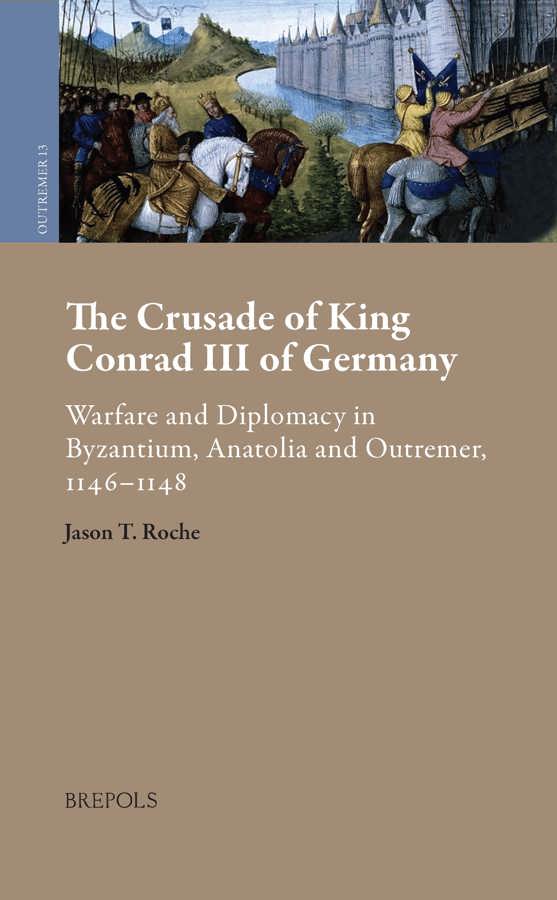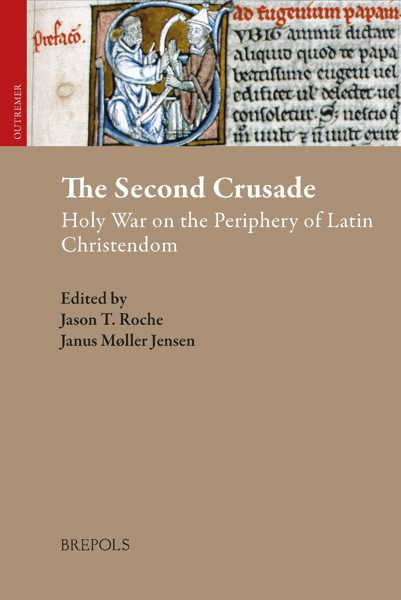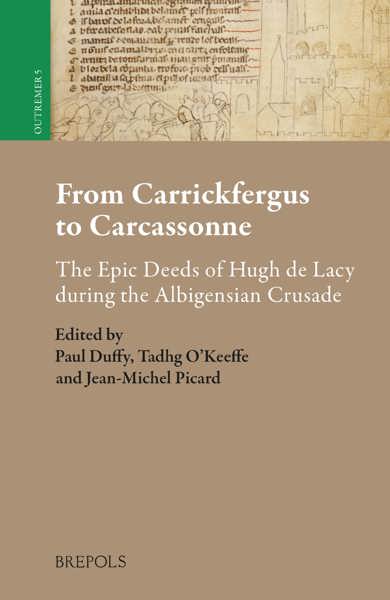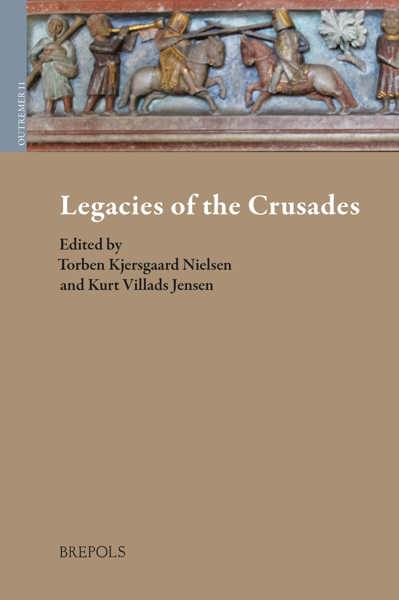
The Crusade of King Conrad III of Germany
Warfare and Diplomacy in Byzantium, Anatolia and Outremer, 1146-1148
Jason T. Roche
- Pages: 365 p.
- Size:156 x 234 mm
- Illustrations:3 b/w
- Language(s):English
- Publication Year:2021
- € 94,00 EXCL. VAT RETAIL PRICE
- ISBN: 978-2-503-53038-3
- Hardback
- Temporarily Out of Stock
- € 94,00 EXCL. VAT RETAIL PRICE
- ISBN: 978-2-503-56095-3
- E-book
- Available
« Au total, un très bon livre renouvelant l’historiographie de la Seconde Croisade. » (Michel Balard, dans Francia-Recensio, 2, 2021)
“Insgesamt gelingt es Roche also durchaus, etablierte Erzählungen über den zweiten Kreuzzug und Konrads Marsch durch Kleinasien in Frage zu stellen (...) eine detaillierte Auseinandersetzung mit dem bisherigen Forschungsstand, die vor allem für Kreuzzugs- und Militärhistoriker von Interesse sein dürfte.” (Gion Wallmeyer, in H-Soz-Kult, 07.09.2021)
“In sum, the book provides scholars with a consistent discussion of both the sources, including many non-Western sources, and of modern historiography. This is remarkable, and the book can only be recommended.” (Karl Borchardt, in The Medieval Review, 21.10.35)
“The Crusade of King Conrad III of Germany represents a model for how intensive research into the daily realities and practicalities of crusading can help both to test the claims made by contemporary authors and to offer new interpretations on the course of events.” (Nicholas Morton, in Al-Masaq Vol XXXIII.3, 2021, p. 356)
« Tout compte fait, l’étude de J.T.R. offre une contribution importante à l’historiographie de la Deuxième croisade. » (Marc Carrier, dans Le Moyen Âge, 128/2, 2022, p. 494)
“Bei einer Beschäftigung mit dem 2. Kreuzzug wird man künftig diese gründliche und faktengesättigte Studie mit ihren interessanten neuen Interpretationsansätzen berücksichtigen müssen (…)” (Peter Thorau, in der Historischen Zeitschrift Heft 316/1, 2023, p. 234)
"Insgesamt legt Jason T. Roche mit seinem Buch eine ambitionierte Studie vor, der es nicht am Mut zu Neuinterpretationen fehlt." (Manuel Kamenzin, in Byzantine Review, Bd. 4 (2022), p. 133)
“Roche’s detailed discussion of the logistical and supply problems that dogged Conrad’s crusade are also of fundamental importance for research on military history and the crusades in general.” (KNUT GÖRICH, in German Historical Institute Bulletin, XLV/2, 2023, p. 94)
“Die detaillierte Aufarbeitung des Kriegszuges, die Auseinandersetzung mit den verfügbaren Quellen und die teils herausfordernden Thesen stellen indes einen spannenden Ausgangspunkt für die weitere Beschäftigung mit dem Kreuzzug Konrads III. dar.” (Manuel Kamenzin, in Byzantine Review, 04.2022.020)
« En tout cas, cet ouvrage intéressant jette un éclairage sur la situation de l'Empire byzantin et la politique de Manuel I durant la deuxième croisade. De plus, en envisageant de manière très concrète le déroulement précis des événements et leurs aspects matériels, et en critiquant et confrontant soigneusement les sources, l'auteur offre une belle leçon à qui cherche à expliquer des evenements. » (Bastien Dumont, dans Revue des études byzantines, 82, 2024, p. 394)
Jason T. Roche is a Senior Lecturer in Medieval History at Manchester Metropolitan University. His research interests cover the history of the crusades and the Latin East and the topography of medieval Anatolia.
This book represents the first work of history dedicated to the crusade of King Conrad III of Germany (1146–48), emperor-elect of the Western Roman Empire and the most powerful man yet to assume the Cross. Even so, many of the people following the king on the Second Crusade were dead before they reached Constantinople and their ranks were devastated in Anatolia. Yet he went on to join with his fellow kings, Louis VII of France and Baldwin III of Jerusalem, in an attempt to capture the city of Damascus, the most powerful Muslim stronghold in southern Syria. Their unsuccessful attack lasted just five days. The recriminations for the many privations and problems the Germans suffered and encountered in Byzantium, Anatolia and Outremer were long and loud and have echoed down the ages: German indiscipline and poor leadership, Byzantine deceit and duplicity, and the self-serving interests of a Latin Jerusalemite nobility were and still are blamed for the various failings of the expedition. Scrutinising the original source evidence to an unparalleled degree and employing a range of innovative, multi-disciplinary approaches, this work challenges the traditional and more recent historiography at every turn leading to a significantly clearer and appreciably different understanding of the expedition’s complex and much maligned history.
Preface and Acknowledgements
Note on Names and Translations
Maps
Abbreviations
Introduction
Chapter One - Key Texts
Odo of Deuil’s De profectione Ludovici VII in orientem
The Greek Texts
Verse Encomia and So-Called ‘Manganeios Prodromos’
The Epitomae of John Kinnamos’s History
Niketas Choniates’s Historia
Chapter Two - Prelude
The Staufer-Komnenian Alliance
Abbot Bernard of Clairvaux and King Conrad III of Germany
Conrad III’s Iter: Royal Command and Princely Assent
Chapter Three - Practicalities
Composition of the Army
Numerical Size of the Army
Victualling on the Via Militaris in 1096 and 1147
Chapter Four - The Army in the Balkans and its Arrival at Constantinople
Braničevo to Naissos
Sardika to Philippopolis
Philippopolis
Philippopolis to Adrianople
Adrianople
Adrianople to Choirobakchoi
Choirobakchoi
The Arrival of the German Army at Constantinople
Violence at the Philopation
Chapter Five - The Army at Constantinople
Conrad III, Manuel I and the Stand-Off Outside Constantinople
Byzantine Reception Ceremonial
Louis VII of France and the French Barons: Fealty and Homage
Conrad III and Manuel I: Proud Inheritors of the Imperial Title of Old Rome
Pikridion and the Propaganda of Legitimisation
Pikridion and the Emperor’s Ascendency over the Staufer Pretenders
Chapter Six - Twelfth-Century Western Anatolia
Chapter Seven - The Army at Nikaia
The Bosphoros to Nikaia
The Pöhlde Annals and the Army’s Arrival at Nikaia
The Route Between Nikaia and Ikonion
Victualling and Logistics
Otto of Freising and the Division of the Army
Chapter Eight - The Advance Towards Ikonion
Traditional Interpretations of the Failure to Advance on Ikonion
The Advance Beyond Dorylaion
The Collapse of the Campaign
‘The mob on foot which was unable to follow the army’
‘For every time our lines strove to charge them, the enemy broke ranks’
‘These men of Belial’
Chapter Nine - Retreat, Detour and Return to Constantinople
‘At the request of our princes and barons, we led the army back to the sea’
The Dorylaion Türkmens and the Attacks on the German Army
The Retreat to Nikaia and Detour to Ephesos
Conrad III’s Return to Constantinople and the Strengthening of the Staufer-Komnenian Alliance
Chapter Ten - The Crusade in Outremer
Raymond of Poitiers, Prince of Antioch
The Council of Palmarea and the Decision to Attack Damascus
Current Interpretations for the Failure of the Attack on Damascus
A Further Explanation for the Failure of the Attack on Damascus
Conclusions
Appendix: Itinerary of Conrad’s Crusade
Bibliography
